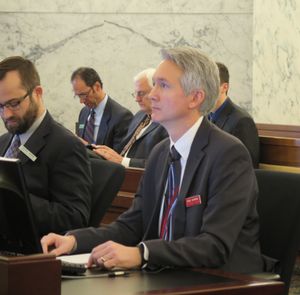JFAC opens week of Health & Welfare budget hearings…
JFAC is opening a week of budget hearings on Health & Welfare related issues, with hearings Monday, Wednesday and Friday focusing on the budget for the Department of Health & Welfare, which currently has a budget of $706.1 million in state general funds, and $2.86 billion in total funds, including the federal government’s roughly 70 percent share of funding for Medicaid, the federal-state program that provides health coverage for poor and disabled citizens. For next year, Health & Welfare requested a 14.1 percent increase in state general funds, 10.3 percent in total funds; Gov. Butch Otter is recommending an 11.6 percent increase in general funds, 9.9 percent total. The governor’s recommendation would bring next year’s Health & Welfare budget to $788.1 million in state general funds, and $3.14 billion total.
“The budget recommendations you will hear throughout this week ... attempt to offer solutions to some pressing unmet health care needs of Idahoans as well as create efficiencies,” Russ Barron, H&W director, told lawmakers this morning. “We’ve seen some encouraging signs that Idaho’s economy is continuing to improve, but many,” he said, are “still struggling.” He said the need, it seems, “never lets up.”
One measure is the amount of federal food stamp benefits paid out each month to Idahoans, he said; that figure dropped from an all-time high of about $31 million a month in May of 2011, to about $17 million a month today. “It continues to steadily decline,” he said.
Eighty-six percent of the Health & Welfare budget goes directly to private providers of care through trustee and benefit payments. Eighty percent of the department’s budget is taken up by Medicaid, and Barron said, “Ninety-seven percent of Medicaid’s $2.5 billion budget is being paid directly to service providers, with only 3 percent spent on administration of the program.”
The agency’s big and complex budget includes supplemental appropriation requests for the current year, some of which already have been approved; various technical adjustments; and 55 line-item requests for next year. It’s broken down into various divisions, and eventually will go into six separate appropriation bills, legislative budget analyst Jared Tatro explained.
Barron highlighted the Idaho Health Care Plan proposal, saying it’ll help address the 250,000 Idahoans who currently have no health insurance. He also pointed to increasing needs in child welfare, as “more children are coming into the care and custody of the department, in part because of the increased drug use (issues) ... that are affecting families.”
Idaho’s fast-growing population also is adding to the department’s workload, he said, along with unmet medical and health care needs. “Our job is to do what we can accomplish within our authority and within our budget,” Barron said.
Otter’s recommendations for Health & Welfare next year include the new dual-waiver health care plan; $2.6 million to start up three more mental health community crisis centers, in Lewiston, Nampa/Caldwell and Pocatello, bringing the total number statewide to seven; a child welfare staffing increase that calls for 13 more positions; expanding youth suicide prevention programs to 17 more Idaho schools; major upgrades to three IT systems, the Child Support Enforcement System, the Child Welfare Information System, and the Medicaid Management Information System, at $17.8 million; and another year of the “Expanded Access” program through which 36 Idaho children with intractable seizure disorders are being treated with a commercial form of marijuana-derived CBD oil as part of a drug trial.
Barron said the Idaho Health Care plan is aimed at “bringing healthier people back into the pool” while also offering “affordable options,” and said, “Waiting for the federal government to fix these problems has gotten us nowhere. Idaho families are still bearing the brunt of these issues. … If we do nothing, insurance rates will cont to climb and families will choose to go without coverage because they can no longer afford to pay full-price premium rates,” which he said can be $1,800 to $2,000 a month. Eventually, he said, as in other states, “The individual market to will start to collapse and carriers will start to pull out.”
The crisis centers, he said, “have been extremely effective at reducing unnecessary hospital visits and jail time.” And the IT upgrades are replacing systems that are 25 years old, Barron said. “We must invest in new technology and systems if we want to continue serving children and families at the service levels they need,” he said. “Today we spend too much time shuffling paper and completing complicated data entry onto old screens.”
Today’s hearings include the divisions of public health services, welfare, indirect support services and licensing & certification. Medicaid is up on Wednesday, along with services for the developmentally disabled, child welfare, and health care policy initiatives; and mental health services, psychiatric hospitalization and substance abuse services are on JFAC’s agenda for Friday.

